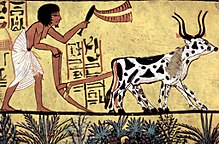旱地農業
外观
此條目可参照英語維基百科相應條目来扩充。 (2021年6月20日) |

 |
| 农业和农学 |
|---|
| 农业史 |
| 農業 |
| 其他類型 |
| 有關 |
| 分類 |
|
|
旱地农业是指与旱地有关的農業,它包括與非灌溉农作物有關的特定农业技术。旱地的氣候特点是一年分為凉爽的雨季(在收获農作物前降雨可以为種植農作物的土壤注入大量水分)和温暖的旱季。[1][2]
描述
[编辑]旱地農業已發展成為一套適應有限水資源的技術和管理實踐,[3]在旱地農業地區,農民在經濟上應該能夠承受偶爾的農作物歉收,或許可以連續幾年。作為旱地農民的生存需要仔細管理作物可用的水分並積極管理費用以盡量減少貧困年份的損失。旱地農業需要不斷評估任何給定作物週期中存在或缺乏的水分含量並進行相應的規劃。旱地農民知道,要想在經濟上取得成功,他們必須在豐年期間積極進取,以抵消乾旱時期的影響。
旱地農業依賴自然降雨,這可能使地面容易受到沙塵暴的影響,特別是如果農業技術不佳或風暴在特別脆弱的時間襲擊的話。事實上,輪作中必須包括休耕期,這意味著田地不能總是受到覆土作物的保護,否則覆蓋作物可能會提供防止侵蝕的保護。
乾旱區農業
[编辑]作為一個研究和發展領域,乾旱區農業或沙漠農業包括研究如何提高缺乏淡水、充足的熱量和陽光的土地的農業生產力,通常還包括以下一項或多項: 極端冬季寒冷、雨季短、鹽鹼地或水、強乾風、土壤結構不良、過度放牧、技術發展有限、貧窮或政治不穩定。
參考文獻
[编辑]- ^ https://www.spektrum.de/lexikon/geographie/dry-farming/1810
- ^ https://www.spektrum.de/lexikon/geographie/regenfeldbau/6507
- ^ Kornei, Katherine. Dry farming could help agriculture in the western U.S. amid climate change. Science News. 9 March 2023 [9 October 2024].
進一步閱讀
[编辑]- Henry Gilbert, Dryland Farming: January 1982–December 1990 (Beltsville, Md.: U.S. Department of Agriculture, National Agricultural Library, 1991)
- Mary W. M. Hargraves, Dry Farming in the Northern Great Plains: Years of Readjustment, 1920–1990 (Lawrence: University of Kansas, 1993)
- Oklahoma State Board of Agriculture, Report (Guthrie, OK: n.p. 1908)
- Dr. John A. Widtsoe, Ph.D. Dry-Farming, A System Of Agriculture For Countries Under A Low Rainfall (NY: The Macmillan Company, 1911)
- Victor Squires and Philip Tow, Dryland Farming: A Systems Approach – An Analysis of Dryland Agriculture in Australia (Sydney: Sydney University Press, 1991)
- O'Bar, Scott, (2013). Alternative Crops for Drylands – Proactively Adapting to Climate Change and Water Shortages. Amaigabe Press, Santa Barbara, CA ISBN 978-0-9882822-0-9
- Encyclopedia of Oklahoma History and Culture – Dry Farming
- P. Koohafkan and B.A. Stewart, Water and Cereals in Drylands published by The Food and Agriculture Organization of the United Nations and Earthscan (PDF)
- Steve Solomon, Water-Wise Vegetables: For the Maritime Northwest Gardener (Sasquatch Books, 1993)
